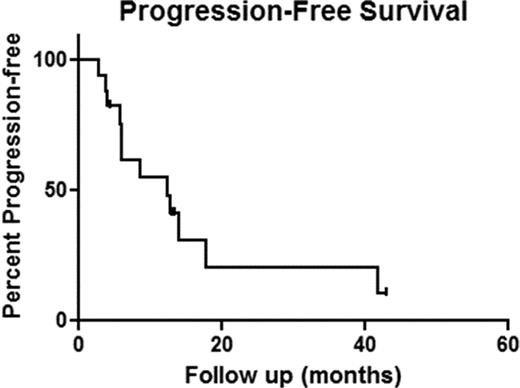Abstract
Abstract 1648
Radioimmunotherapy capitalizes on the radiosensitivity of non-Hodgkin lymphoma (NHL) and the targeted nature of monoclonal antibody therapy. In an attempt to reverse bone marrow infiltration with B-cells and, hence, optimize the biodistribution and tumor dosimetry of 90Y-ibritumomab tiuxetan, we conducted a multicenter, dose escalation, open label study to determine maximum tolerated dose (MTD), safety, and efficacy of a single course of 90Y-ibritumomab tiuxetan after four weekly doses of rituximab in relapsed or refractory low-grade or follicular or transformed CD20+ B-cell NHL.
A course of therapy included an initial dose of rituximab 250 mg/m2 plus 5 mCi of 111In- ibritumomab tiuxetan followed by three weekly doses of rituximab at 375 mg/m2 followed two weeks later by rituximab 250 mg/m2 plus 5 mCi of 111In-ibritumomab tiuxetan. Gamma camera imaging for dose estimates was conducted on days 1 and 36 following infusion of 111In- ibritumomab tiuxetan. If dose estimates were in the safe defined limits, and bone marrow on day 29 had less than 25% involvement by NHL, patients received on day 43 250 mg/m2 of rituximab plus a dose of 90Y-ibritumomab tiuxetan. Patients were scheduled to receive 90Y- ibritumomab tiuxetan in one of the dose escalation cohorts (0.4, 0.5, 0.6, 0.7 mCi/kg). Eligible patients were required to have histologically confirmed, relapsed or refractory low-grade or follicular or transformed B-cell NHL with demonstrable monoclonal CD20+ B-cell population in the lymph nodes or bone marrow. Patients with impaired bone marrow reserve, as indicated by prior myeloablative therapies with stem cell rescue, hypocellular marrow, history of failed stem cell collection or external beam radiation therapy to >25% of active bone marrow, and marked reduction in bone marrow precursors of one or more cell lines, were excluded.
Cohort 1 (0.4 mCi/kg) enrolled 5 patients. Dose escalation was held after significant hematologic toxicity was observed in those patients (1 patient developed grade 4 and 3 grade 3 reversible thrombocytopenia, 4 patients developed grade 4 reversible leukopenia and neutropenia, and 1 patient developed grade 4 febrile neutropenia). One patient in this cohort did not receive the study drug due to the toxicity observed in the previous patients.
The protocol was amended and 6 patients were enrolled at a lower dose cohort (0.3 mCi/kg); 1 patient experienced grade 4 neutropenia, whereas grade 3 leukopenia, neutropenia, and thrombocytopenia were seen in 2, 3, and 3 patients respectively. As the 0.3 mCi/kg dose was well tolerated, the 0.4 mCi/kg cohort was expanded to enroll 6 additional patients. In the expansion cohort, Grade 4 leukopenia and neutropenia were seen in 1 and 2 patients respectively; also, grade 3 leukopenia, neutropenia, and thrombocytopenia were seen in 3, 4, and 4 patients, respectively.
All hematologic toxicities were reversible and no non-hematologic toxicities were seen with the exception of grade 1 fatigue in 2 patients. Among those who developed hematologic toxicities, the median duration of at least grade 3 leukopenia, neutropenia, and thrombocytopenia were 12 (range, 7–37), 10 (7–30), and 12 (3–44) days, respectively. Six patients had bone marrow involvement by NHL at registration ranging from <5% to 20%. Following 4 weekly doses of rituximab, marrow involvement decreased in all patients with complete clearance in 3 of them.
In an intention-to-treat analysis, complete remission, partial remission, stable and progressive disease was achieved in 6 (35%), 8 (47%), 2 (12%), and 1(6%) patients, respectively (fig 1). With a median follow up of 31.7 months (range, 4.3 – 92.6 months), the median progression free survival (fig 2) and time to next treatment (fig 3) were 12.3 and 10.9 months, respectively. The median overall survival has not been reached.
Waterfall plot (* patient did not receive 90Y- ibritumomab tiuxetan)
The MTD of 90Y-ibritumomab tiuxetan administered to patients who have NHL marrow infiltration <25% following 4 weekly doses of rituximab was 0.4 mCi/kg. A 4 weekly course of rituximab decreased NHL marrow infiltration in all patients with marrow involvement and led to complete clearance in 50% of them. Although this regimen was associated with a high response rate, the hematologic toxicity was significant.
No relevant conflicts of interest to declare.
Author notes
Asterisk with author names denotes non-ASH members.




This feature is available to Subscribers Only
Sign In or Create an Account Close Modal